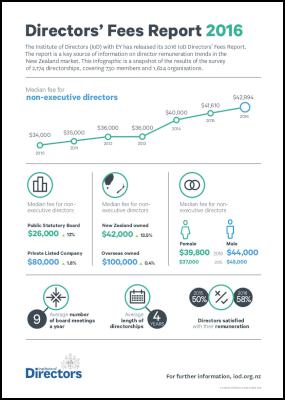Directors’ fees – signs of improving diversity

Click for big version.
Directors’ fees – signs of improving diversity
The Institute of Directors’ 2015 Directors’ Fees Report shows directors’ fees have risen moderately this year, with pay disparities between male and female directors closing.
Institute of Directors Chief Executive Simon Arcus says the median increase in non-executive directors’ fees increased by 3% (4% in 2015), with the gap between male and female non-executive directors being 10%, a drop from 21% in 2015.
“The right balance between risk and reward is critical to attracting skilled, competent and diverse talent to your board table,” Mr Arcus says. “What New Zealand needs is highly skilled, fairly remunerated directors. It’s not enough to say there are plenty of directors lining up out there: New Zealand needs a focus on quality not quantity.”
The IoD’s annual director remuneration survey is the key source of information on director remuneration trends in New Zealand. This year fee levels moved at a similar pace to 2015. For non-executive directors the median rose from $41,610 in 2015 to $42,994 in 2016. For non-executive chairs the median fees increased from $52,500 to $54,000.
The male non-executive median fee is $44,000, a drop from $45,000 last year, while the female non-executive median increased from $37,000 to $39,800. Mr Arcus says given the not for profit sector is not traditionally well remunerated, this improvement is highly likely to have come from the corporate sector.
According to the IoD-NZIER Director Sentiment survey, of current serving directors, 60% agree diversity is a key consideration in making new appointments. Female non-executive directors comprise of 29.7% of the total sample, up from 26.9% in 2015.
“There are good economic arguments for getting the right skill mix, and gender, onto boards. Research shows even one woman on a board can enhance its performance. It’s time to see the diversity statistics improve,” Mr Arcus says. Mr Arcus said it is also pleasing the disparity between New Zealand and overseas owned companies decreased. Non-executive director pay in New Zealand owned companies moved 13.5% from $37,000 to $42,000, while overseas owned companies increased just $375 to $100,000 from $99,625 in 2015.
“The state sector continues to feature significantly lower rates for those contributing to the public interest. Some public service element to pay may be justified but it would be a concern if lower rates simply meant quality directors with significant experience exercised their choice to limit their involvement because of a failure to recognise the significant personal risk they take on in many public sector roles,” Mr Arcus says.
This is the second year the IoD worked with EY to undertake our annual IoD Directors’ Fee Survey, and this year saw a 8.3% boost in survey participation from IoD members covering 22.5% more organisations, making it the most comprehensive in our history.
Survey data showed 58% were satisfied with their current level of remuneration, Arcus says, compared with 50.6% in 2015. Mr Arcus says: “New Zealand needs directors who are courageous but for whom the risk and reward balance in remuneration makes sense.”
-Ends-


 Cawthron Institute: Independent Science Could Break Stalemates In Global Plastics Treaty Negotiations
Cawthron Institute: Independent Science Could Break Stalemates In Global Plastics Treaty Negotiations KiwiRail: Great Journeys New Zealand Brings The ‘WOW’ Factor With VIP Packages
KiwiRail: Great Journeys New Zealand Brings The ‘WOW’ Factor With VIP Packages Parrot Analytics: Despite Profits, Disney+ Lags Netflix And Amazon Prime Video In Key Regions
Parrot Analytics: Despite Profits, Disney+ Lags Netflix And Amazon Prime Video In Key Regions Plant And Food Research: Creating A New Opportunity From An Invasive Challenge
Plant And Food Research: Creating A New Opportunity From An Invasive Challenge Stats NZ: Total Greenhouse Gas Emissions Fall 0.7 Percent In The September 2024 Quarter
Stats NZ: Total Greenhouse Gas Emissions Fall 0.7 Percent In The September 2024 Quarter Takapuna Beach Business Association: Takapuna Outpaces Auckland With Strong Economic Growth In 2024
Takapuna Beach Business Association: Takapuna Outpaces Auckland With Strong Economic Growth In 2024



